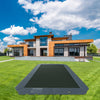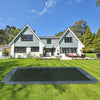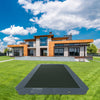How to Prepare Your Yard Before Installing an In‑Ground Trampoline
Installing an in-ground trampoline is a fantastic way to create a safe, fun, and visually pleasing play area in your backyard. Unlike above-ground models, in-ground trampolines offer a lower profile, easier access for kids, and a more integrated look with your landscaping. But before the jumping can begin, there’s a bit of thoughtful prep work involved. If you’re considering an inground trampoline installation for your family, this guide will walk you through everything you need to know to prepare your yard properly.
Assess Your Backyard Space
Start by taking a good look at your backyard. Think about how much open space you have and how the trampoline will fit in with existing landscaping, gardens, and play equipment. A flat or gently sloped area is ideal for inground trampoline installation.
Consider how much room you’ll need around the trampoline. You’ll want at least 3 feet of clearance on all sides for safe play and easy maintenance. This means that even a 12-foot trampoline will need a minimum of 18 feet of open space in your yard.
Choose the Right Location
Once you’ve assessed your space, it’s time to choose the ideal location. You’ll want a spot that’s visible from your home so you can easily keep an eye on the kids while they’re jumping. A central or frequently used part of the yard is often better than a far-off corner.
Avoid placing the trampoline too close to fences, sheds, or hard surfaces like patios. Also, try to pick a location with some natural wind protection—trees or fencing can help reduce gusts that might affect safety. Sun exposure is another factor, a mix of sun and shade is ideal for an inground trampoline.
Check Ground Surface and Stability
Before you start digging, it’s important to understand the makeup of your soil. Is it mostly clay, sand, or loam? Each type will drain water differently, which is critical for inground trampoline installation. A quick soil stability test can help: dig a small hole about a foot deep and pour water into it. If it drains quickly, your soil is probably suitable. If the water lingers, you’ll need to address drainage before installation.
Understand Local Regulations and Permits
Every city and neighborhood is different, so it’s a good idea to check with your local building department or HOA before you start your inground trampoline installation. Some areas require permits for backyard structures that involve excavation, especially if you're digging near utility lines.
Call 811 or your local utility locator to mark any underground lines before digging. This is both a legal requirement and a safety necessity. Also, be sure to understand your property lines. You don’t want to dig too close to a neighbor’s yard.
Select the Right Trampoline Size and Type
The size and type of trampoline you choose will depend on your space, your budget, and the age range of your kids. Here are a few general guidelines:
-
10-foot trampolines are great for younger kids and smaller yards.
-
12-foot trampolines are ideal for most families, offering a balance between space and bounce area.
-
14-foot or larger trampolines provide ample space for older kids and teens.
As for shape, round trampolines tend to keep jumpers in the center and are ideal for younger children. Rectangular trampolines offer more control and are popular for gymnastics or older kids practicing tricks. Oval trampolines offer a happy medium.
Make sure the model you choose is designed for inground trampoline installation. These models are built differently from above-ground ones and come with features like vented pads and specific frame designs that work below surface level.
Plan for Safety Features and Accessories
Safety should always come first when installing an in-ground trampoline. Add padded safety covers for springs and frames, even if the trampoline sits flush with the ground. Some families also opt for low-profile net enclosures, especially for younger jumpers.
You can also enhance the area around the trampoline by installing rubber mulch or synthetic turf. Other accessories to consider include jump mats with UV protection, weather covers, and LED lighting for evening play.
Think About Drainage and Weather Conditions
Proper drainage is one of the most important aspects of a successful inground trampoline installation. There are several drainage solutions to consider:
-
Gravel base: Helps water percolate and prevents standing water
-
French drain: Redirects water away from the trampoline area
-
Sump pump: Useful in areas with high water tables or heavy rain
If you live in an area with frequent rain or snow, these solutions are especially important. Also, make sure the trampoline is made with weather-resistant materials to prevent rust and fading.
Prepare the Site for Installation
Once your location is chosen and all considerations are handled, it’s time to prepare the site:
-
Mark the footprint of the trampoline based on the manufacturer’s specs.
-
Excavate the hole, sloping or stepping the walls depending on the design.
-
Install the drainage system, such as a gravel base or piping.
-
Compact the soil around the edges to avoid shifting or cave-ins.
-
Place the trampoline frame and mat securely, ensuring it sits level.
Depending on the model, you may also need to install a retaining wall or pit liner to support the structure.
Set a Budget and Timeline
An inground trampoline installation is a worthwhile investment. Depending on whether you hire a professional or do it yourself, here’s what to expect:
-
Trampoline Kit: $1,000–$3,000
-
Excavation & Labor: $500–$2,000 (varies by location)
-
Drainage System: $150–$500
-
Accessories and Safety Gear: $100–$500
Most installations take 1 to 3 days, depending on weather and ground conditions. Be sure to account for extra time if you need a permit or help from a contractor.
Frequently Asked Questions
How to prepare the ground for trampoline installation?
Start by clearing and leveling the area. Then dig a hole according to your trampoline’s specifications, install a drainage system, and compact the surrounding soil to ensure stability.
How much does it cost to install an inground trampoline?
Costs range from $1,500 to $4,000 or more, depending on size, labor, and site requirements. DIY installation can lower the cost, but professional installation ensures everything is done correctly.
How much space is required for a backyard trampoline?
Leave at least 3 feet of clearance around the trampoline and overhead space free from obstacles.
How deep do you need to dig for an inground trampoline?
Most in-ground trampolines require a central depth of about 3 feet, with sloped or stepped sides for structural support and proper drainage.
Do you need a permit for an inground trampoline?
In many areas, yes. Always check with your local municipality or HOA to determine if a permit is required before installing your inground trampoline.



